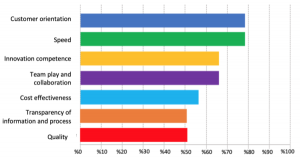Digital transformation shouldn’t sacrifice consumer trust. Grow your brand through AI and other tools while safeguarding your reputation.

With consumers performing an increasing number of transactions online, the importance of digital transformation in 2024 is immense. New digital tools, workflows and AI technologies can increase organizational value and operational efficiency, but it should not come at the expense of the hard-won consumer trust.
After all, 63% of a company’s market value is driven by reputation, demanding marketers protect their brand when leveraging new digital tools and workflows.
Brand risks during digital transformation
Digital transformation relies on informed experimentation — strategically testing new ways to optimize existing workflows and online presence. But experiments come with risks, from minor to existential. Brands must anticipate the risks of digital transformation to minimize their negative impact and maximize their ROI potential.
AI tool limitations
Because AI technology is still in its infancy and far from infallible, AI-generated content tends to appear machine-made and fails to connect with humans. Uncareful use of AI tools can hinder your brand’s efforts to create personal connections with customers (a huge risk in today’s digital environment).
Worse yet, AI can be inaccurate or biased, damaging the customer experience. For example, AI chatbots lack the nuance for human conversations, creating unsatisfactory exchanges. Or, AI-generated content can produce errors and unintentionally deceptive marketing. If the information is erroneous enough to be deemed harmful, legal liability can arise.
Overall, AI tools that aren’t trained on the brand ethos and values, grounded in brand needs and policy or carefully monitored by humans become vulnerabilities.
In a comparison study of AI tools, we discovered that, at this stage, AI platforms and tools cannot match the quality — accuracy, readability and style — of professional content writers.
Inconsistent brand experience
In today’s chaotic consumer journeys, your brand must be present wherever and whenever consumers seek help. For your presence to make a difference, you need a consistent narrative and experience across consumer touchpoints. If not, building brand equity and trust-based consumer relationships is an uphill battle.
Disjointed transformation efforts
A lack of internal clarity and communication about your brand’s digital transformation creates fragmented efforts not based on or connected to the overarching business strategy. Unclear KPI alignment, inconsistent impact reporting and other lapses can sabotage the best efforts.
During times of miscommunication, key stakeholders may face frustration and burnout or may even leave. This situation squanders opportunities to develop your biggest brand ambassadors — employees.
Steps to safeguard your brand during digital transformation
The good news is that your team can mitigate the risks and brand liabilities of implementing new digital strategies. It starts with understanding the risks.
Be mindful of AI tool integration and be ready to evolve
Carefully monitor and regularly refine your AI tools. Understand where they can help you and where they need more oversight. As our study showed, AI tools can support content ideation, sourcing and inspection — as long as human writers review the final product.
Brands should form teams of AI experts for oversight. These teams can outline AI governance strategies and monitor AI tools. Involving employees is one way to access the value of AI without sacrificing the personalized, high-quality content that human audiences demand.
Use clear internal communication
Define KPIs and goals early and often. Reference them to keep the team aligned and motivated and openly discuss or brainstorm strategy shifts as needed.
Successful digital transformation also requires creative thinkers who are empowered to solve problems. You can develop them by investing in your corporate culture to promote innovation, ownership and collaboration.
Maintain brand consistency
All marketing materials and efforts should be grounded in a set of core-owned assets, including your brand values, identity, mission and purpose. A strong brand foundation will bolster marketing efforts and content assets, ensuring a cohesive brand experience.
A unified experience encourages traffic to your website. This will minimize the impact of inconsistent digital offerings and provide a controlled environment for your brand to connect with consumers. Prioritize the most impactful projects and realize your progress won’t happen overnight.
Follow a consumer-centric strategy
Today’s consumers rely on digital tools like Google and social media to research brands and services before committing to a transaction. Your brand must build a strategy to stay ready to receive and help consumers when and where they’re searching.
Use reception marketing to ensure your digital transformation is informed by accurate consumer data. Where are they looking for answers? And how are they moving through their journeys? Consumer intent insights should inform your digital strategy so you can reach and connect with consumers authentically.
Grow your brand and protect it at the same time
Despite the risks and pitfalls, the benefits of pursuing digital transformation are worth it.
Navigating this transformation requires new knowledge, skill sets and policies to maximize the benefits of new technology like AI, which continues to expand. Brands that want to lead need to take action and invest accordingly — before the competition catches up.
The post How to safeguard your brand during a digital transformation appeared first on MarTech.
(32)








